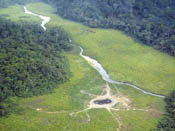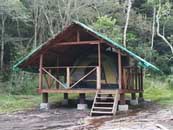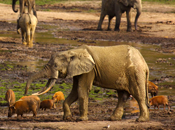

Langoue research camp
Langoue is located in Ivindo National Park. Discovered by Mike Fay in 2000, the bai is a clearing in the 

The accommodation
Accommodation at present is basic and only for the hardy African traveller but the wildlife and sheer wilderness of 

How to get to the camp
To get to the bai, you must first take the train to Ivindo, a small forestry town in central Gabon. You will take the 

The Bai
The Bai is a one hour walk from camp with a steep hill at the end. There are three platforms in trees along the edge 

Author: John Marais
Things to do
Discover the forest
During your stay at Langoue Bai Camp, you can head out into the forest on your own expedition with one of the eco-guides. The walks into or alongside the bai are amazing. Or camp outside on one of the platforms. The camp staff will provide you with hot tea and sleepingbags. But be aware; this is only for those who have been to Africa numerous times before and for those who doesnt know fear.
Animals at the bai:
Elephant and gorilla visitation at the bai is seasonal. Elephants are present more often during the rainy season, with peaks in April through June and November till January. Gorillas visits peak in April, June and July. Total numbers of gorillas and elephants in the bai are the same time rarely exceed 10 and 15 respectively. Furthermore, gorilla viewing is usually at a distance of roughly 200 meters, so come prepared with appropriate photographic equipment. Please be prepared for the possibility to not see them. As with any animal- based tourism, animal movement cannot be controlled and it thus cannot be promised that you will see what you came for. On the bright side, if you stay a few days, you will likely see elephants and forest buffalo and guaranteed to see sitatungas, monkeys and many interesting birds.
A note on Central Africa
For those visitors who have already visited western and souther Africa on safari vacations, the following is a note on the differences you will encounter when visiting Central Africa. This region of Africa is almost entirely forested with means many things for the visitor. First and foremost, it means that you will not have the incredible wildlife viewing as seen on a savannah. Animals are secretive in the forest and difficult to see. Once you arrive and spend some time in the forest, you will realize that the forest itself is the most exciting part of being here. Biodiversity is incredibly high, and there is no shortage of small and interesting things to look at if you are quiet and patient. Second, with the exception of the time you spend at the bai on the platform, you will not have the photo opportunities you have on safari. Again, this is a forest experience, and the forest is quiet, shady, cool and mostly dense. Lastly, remember that WCS is a conservation organization and not a real safari company. When you visit Langoue Bai, you will be considered guests of the research team. Come prepared for rustic conditions with a desire to look, to listen and to learn, and you will quickly begin to appreciate everything the forest has to offer.
And on great ape health:
In addition to the protection of visitors of Langoue Bai and their staff, WCS is also responsible for the health of the wild animals living in Langoue. Great apes are of particular concern because their similarity to us makes them vulnerable to a number of human diseases. For this reason, it is also required that every visitor to Langoue Bai provide proof that they have updated vaccinations for the following diseases:
Polio (not viral), Tetanus, Measles, Hepatitis A, Yellow Fever and Proof of recent negative skin test for Tuberculosis OR Vaccination. Please come with photocopies of doctors receipt or World Healt Organisation International Vaccination cards. Without this documentation, you will not be allowed to come to Langoue.
And because of the highly isolated living conditions at Langoue Bai, visitors need to provide proof of emergency medical insurance. Before departure, you need to send 2 photocopies of medical insurance information including phone numbers and details of evacuation procedures.